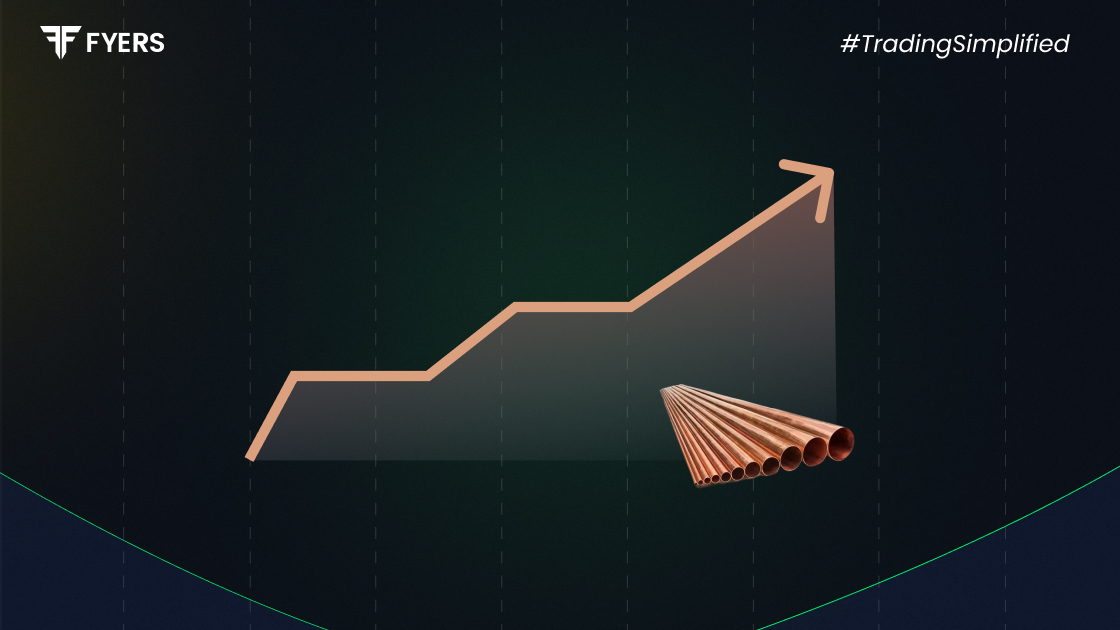

 30 Jun, 2025
30 Jun, 2025
 4 mins read
4 mins read

Commodities like copper play a vital role in global trade and industrial development. Among base metals, copper stands out for its widespread use in construction, power transmission, electronics, and manufacturing. In India, copper futures trading offers investors and traders a regulated platform to profit from price movements while managing risk effectively.
This guide explains what are copper futures, how to trade copper futures in India, key factors affecting copper prices, and the benefits and risks involved.
Copper futures are standardised derivative contracts that obligate the buyer or seller to purchase or sell a specific quantity of copper at a predetermined price on a future date. In India, these contracts are traded primarily on the Multi Commodity Exchange (MCX).
Copper futures serve two primary purposes:
Hedging: For businesses that are vulnerable to copper price fluctuations.
Speculation: For traders aiming to profit from price volatility in the copper futures market.
Each contract defines quantity (lot size), quality, and settlement terms, making copper trading a structured and transparent investment route.
If you’re new to MCX copper futures, here’s how to start:
1. Open a Commodity Trading Account
Choose a SEBI-registered broker like Zerodha, FYERS, or Angel One that offers copper futures trading on MCX.
2. Select the Right Contract
MCX offers copper futures with different expiry dates. Choose based on your trading goals - whether short-term or long-term.
3. Conduct Market Analysis
Use technical indicators (like RSI, MACD, moving averages) and fundamental research to form a market view. Stay updated on news impacting the copper futures market globally.
4. Place Orders
Decide how many lots you want to trade. The standard lot size for copper futures is 1 metric tonne (1,000 kg), and MCX also offers mini contracts of 250 kg.
5. Monitor and Exit
Track your trade, set stop-loss or target prices, and exit before expiry unless you're prepared for physical delivery.
Several domestic and international dynamics influence copper prices:
Global Demand: China, the U.S., and India are major copper consumers. Changes in industrial activity can shift demand.
Mining Supply: Disruptions due to strikes, natural disasters, or geopolitical issues can affect global supply.
US Dollar Index: Copper is globally traded in USD. A stronger dollar usually makes copper more expensive in other currencies, reducing demand.
Inventory Levels: Stockpiles in global warehouses (like LME, SHFE) reflect the supply-demand balance.
Energy Prices: Mining is energy-intensive. High energy costs may raise production costs and influence copper prices.
Inflation & Interest Rates: Higher inflation or rate hikes often lead to greater investment in commodities, including copper.
Understanding these factors affecting copper prices helps traders anticipate trends and adjust their strategies accordingly.
Trading copper on MCX offers several advantages:
Leverage: You only need to pay a margin to control a large contract value, increasing your potential returns.
Liquidity: MCX copper futures are highly liquid, which means easy entry and exit at competitive prices.
Hedging: Businesses using copper can hedge against price volatility and protect their profit margins.
Diversification: For equity and forex traders, copper trading adds a non-correlated asset to the portfolio.
Transparency: SEBI regulations and electronic platforms ensure transparent price discovery and fair practices.
Despite its potential, copper futures trading also involves risks:
High Volatility: Prices can be impacted by sudden global events or shifts in demand/supply.
Leverage Risk: Just as leverage magnifies gains, it can also increase losses if the market moves against your position.
Delivery Obligations: If you hold a position till expiry in a physical contract, you might need to take or give delivery.
Regulatory Changes: New SEBI rules or changes in trading margins can impact your positions.
Overexposure: Focusing too much on a single commodity like copper may increase risk.
Always trade with a defined plan, including stop-losses and position sizing to manage exposure.
Copper futures trading in India provides an exciting opportunity for both hedgers and speculative traders to benefit from movements in one of the world’s most important industrial metals. With rising demand driven by infrastructure, electric vehicles, and renewable energy, copper is expected to remain a strategic asset.
However, success in the copper futures market demands knowledge, discipline, and risk management. Whether you're a beginner or an experienced trader, understanding how to trade copper futures and the factors affecting copper prices is essential to make informed decisions.
You can trade copper futures on the Multi Commodity Exchange (MCX) through SEBI-registered brokers like Zerodha, Angel One, and FYERS.
The standard lot size for copper futures is 1,000 kg (1 metric tonne). MCX also offers a mini copper contract of 250 kg.
Major factors affecting copper prices include global demand, mining disruptions, USD strength, inventory levels, energy prices, and macroeconomic indicators.
Yes, it involves price volatility, leverage risk, and potential delivery obligations. Traders should use proper risk management techniques and stay informed.
Copper offers high liquidity, strong global demand, and diversification benefits, making it a popular choice in commodity portfolios.
Calculate your Net P&L after deducting all the charges like Tax, Brokerage, etc.
Find your required margin.
Calculate the average price you paid for a stock and determine your total cost.
Estimate your investment growth. Calculate potential returns on one-time investments.
Forecast your investment returns. Understand potential growth with regular contributions.